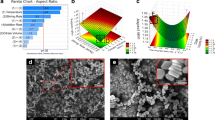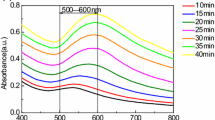Abstract
The current investigation deciphers aggregation pattern of gold nanoparticles (AuNPs) and lipid-treated AuNPs when subjected to aqueous sodium chloride solution with increasing ionic strengths (100–400 nM). AuNPs were synthesized using 0.29 mM chloroauric acid and by varying the concentrations of trisodium citrate (AuNP1 1.55 mM, AuNP2 3.1 mM) and silver nitrate (AuNP3 5.3 μM, AuNP4 10.6 μM) with characteristic LSPR peaks in the range of 525–533 nm. TEM analysis revealed AuNPs to be predominantly faceted nanocrystals with the average size of AuNP1 to be 35 ± 5 nm, AuNP2 15 ± 5 nm, AuNP3 30 ± 5 nm, and AuNP4 30 ± 5 nm and the zeta-average for AuNPs were calculated to be 31.23, 63.80, 26.08, and 28 nm respectively. Induced aggregation was observed within 10 s in all synthesized AuNPs while lipid-treated AuNP2 (AuNP2-L) was found to withstand ionic interferences at all concentration levels. However, lipid-treated AuNPs synthesized using silver nitrate and 1.55 mM trisodium citrate (AuNP3, AuNP4) showed much lower stability. The zeta potential values of lipid-treated AuNPs (AuNP1-L-1x/200, − 17.93 ± 1.02 mV; AuNP2-L-1x/200, − 21.63 ± 0.70; AuNP3-L-1x/200, − 14.54 ± 0.90; AuNP3-L-1x/200 − 13.77 ± 0.83) justified these observations. To summarize, AuNP1 and AuNP2 treated with lipid mixture 1 equals or above 1x/200 or 1x/1000 respectively showed strong resistance against ionic interferences (up to 400 mM NaCl). Use of lipid mixture 1 for obtaining highly stable AuNPs also provided functional arms of various lengths which can be used for covalent coupling.

Agglomeration behavior of gold nanoparticles before and after lipid capping







Similar content being viewed by others
References
Abhijith KS, Sharma R, Ranjan R, Thakur MS (2014) Facile synthesis of gold–silver alloy nanoparticles for application in metal enhanced bioluminescence. Photochemical & Photobiological Sciences 13(7):986–991
Aioub M, El-Sayed MA (2016) A real-time surface enhanced Raman spectroscopy study of plasmonic photothermal cell death using targeted gold nanoparticles. J Am Chem Soc 138(4):1258–1264
Borghei YS, Hosseini M, Dadmehr M, Hosseinkhani S, Ganjali MR, Sheikhnejad R (2016) Visual detection of cancer cells by colorimetric aptasensor based on aggregation of gold nanoparticles induced by DNA hybridization. Anal Chim Acta 904:92–97
Dichello GA, Fukuda T, Maekawa T, Whitby RL, Mikhalovsky SV, Alavijeh M, Pannala AS, Sarker DK (2017) Preparation of liposomes containing small gold nanoparticles using electrostatic interactions. Eur J Pharm Sci 105:55–63
Engelbrekt C, Jensen PS, Sørensen KH, Ulstrup J, Zhang J (2013) Complexity of gold nanoparticle formation disclosed by dynamics study. J Phys Chem C 117(22):11818–11828
Fratoddi I, Venditti I, Cametti C, Russo MV (2015) How toxic are gold nanoparticles? The state-of-the-art. Nano Res 8(6):1771–1799
Gao ZF, Song WW, Luo HQ, Li NB (2015) Detection of mercury ions (II) based on non-cross-linking aggregation of double-stranded DNA modified gold nanoparticles by resonance Rayleigh scattering method. Biosens Bioelectron 65:360–365
Ghasemi F, Hormozi-Nezhad MR, Mahmoudi M (2015) A colorimetric sensor array for detection and discrimination of biothiols based on aggregation of gold nanoparticles. Anal Chim Acta 882:58–67
Gupta A, Moyano DF, Parnsubsakul A, Papadopoulos A, Wang LS, Landis RF, Das R, Rotello VM (2016) Ultrastable and biofunctionalizable gold nanoparticles. ACS Appl Mater Interfaces 8(22):14096–14101
Hamilton DJ, Coffman MD, Knight JD, Reed SM (2017) Lipid-coated gold nanoparticles and FRET allow sensitive monitoring of liposome clustering mediated by the synaptotagmin-7 C2A domain. Langmuir 33(36):9222–9230
Han X, Goebl J, Lu Z, Yin Y (2011) Role of salt in the spontaneous assembly of charged gold nanoparticles in ethanol. Langmuir 27(9):5282–5289
Hassan M, Haque E, Reddy KR, Minett AI, Chen J, Gomes VG (2014) Edge-enriched graphene quantum dots for enhanced photo-luminescence and supercapacitance. Nano 6(20):11988–11994
Kalakonda P, Sreenivas B (2017) Synthesis and optical properties of highly stabilized peptide-coated gold nanoparticles. Plasmonics 12(4):1221–1225
Kang JH, Ko YT (2015) Lipid-coated gold nanocomposites for enhanced cancer therapy. Int J Nanomed 10(Spec Iss):33–45
Khlebtsov N, Dykman L (2011) Biodistribution and toxicity of engineered gold nanoparticles: a review of in vitro and in vivo studies. Chem Soc Rev 40(3):1647–1671
Kim T, Lee CH, Joo SW, Lee K (2008) Kinetics of gold nanoparticle aggregation: experiments and modeling. J Colloid Interface Sci 318(2):238–243
Kim MS, Kim GW, Park TJ (2015) A facile and sensitive detection of organophosphorus chemicals by rapid aggregation of gold nanoparticles using organic compounds. Biosens Bioelectron 67:408–412
Kim DY, Shinde S, Ghodake G (2017) Tuning stable and unstable aggregates of gallic acid capped gold nanoparticles using Mg 2+ as coordinating agent. J Colloid Interface Sci 494:1–7
Li B, Li X, Dong Y, Wang B, Li D, Shi Y, Wu Y (2017) Colorimetric sensor array based on gold nanoparticles with diverse surface charges for microorganisms identification. Anal Chem 89(20):10639–10643
Lin JH, Chang CW, Wu ZH, Tseng WL (2010) Colorimetric assay for S-adenosylhomocysteine hydrolase activity and inhibition using fluorosurfactant-capped gold nanoparticles. Anal Chem 82(21):8775–8779
Narkeviciute I, Chakthranont P, Mackus AJ, Hahn C, Pinaud BA, Bent SF, Jaramillo TF (2016) Tandem core–shell Si–Ta3N5 photoanodes for photoelectrochemical water splitting. Nano Lett 16(12):7565–7572
Piella J, Bastús NG, Puntes V (2016) Size-controlled synthesis of sub-10-nanometer citrate-stabilized gold nanoparticles and related optical properties. Chem Mater 28(4):1066–1075
Priyadarshini E, Pradhan N (2017) Gold nanoparticles as efficient sensors in colorimetric detection of toxic metal ions: a review. Sensors Actuators B Chem 238:888–902
Ranjan R, Esimbekova EN, Kirillova MA, Kratasyuk VA (2017a) Metal-enhanced luminescence: current trend and future perspectives—a review. Anal Chim Acta 971:1–13
Ranjan R, Esimbekova EN, Kratasyuk VA (2017b) Rapid biosensing tools for cancer biomarkers. Biosens Bioelectron 87:918–930
Reddy KR, Lee KP, Gopalan AI (2007) Self-assembly directed synthesis of poly (ortho-toluidine)-metal (gold and palladium) composite nanospheres. J Nanosci Nanotechnol 7(9):3117–3125
Reddy KR, Lee KP, Gopalan AI (2008a) Self-assembly approach for the synthesis of electro-magnetic functionalized Fe 3 O 4/polyaniline nanocomposites: effect of dopant on the properties. Colloids Surf A Physicochem Eng Asp 320(1):49–56
Reddy KR, Sin BC, Yoo CH, Park W, Ryu KS, Lee JS, Sohn D, Lee Y (2008b) A new one-step synthesis method for coating multi-walled carbon nanotubes with cuprous oxide nanoparticles. Scr Mater 58(11):1010–1013
Reddy KR, Gomes VG, Hassan M (2014) Carbon functionalized TiO2 nanofibers for high efficiency photocatalysis. Materials Research Express 1(1):015012
Remant Bahadur KC, Aryal S, Bhattarai SR, Bhattarai N, Kim CH, Kim HY (2006) Stabilization of gold nanoparticles by hydrophobically-modified polycations. J Biomater Sci Polym Edit 17(5):579–589
Showkat AM, Zhang YP, Kim MS, Gopalan AI, Reddy KR, Lee K (2007) Analysis of heavy metal toxic ions by adsorption onto amino-functionalized ordered mesoporous silica. Bull Kor Chem Soc 28(11):1985–1992
Sun M, Liu F, Zhu Y, Wang W, Hu J, Liu J, Dai Z, Wang K, Wei Y, Bai J, Gao W (2016) Salt-induced aggregation of gold nanoparticles for photoacoustic imaging and photothermal therapy of cancer. Nano 8(8):4452–4457
Thakur MS, Ranjan R, Vinayaka AC, Abhijith KS, Sharma R (2013) Nanoparticles and biophotonics as efficient tools in resonance energy transfer-based biosensing for monitoring food toxins and pesticides. In: Park B, Appell M (eds) Advances in applied nanotechnology for agriculture. American Chemical Society, Washington, D.C., pp 55–84
Thatai S, Khurana P, Prasad S, Soni SK, Kumar D (2016) Trace colorimetric detection of Pb2+ using plasmonic gold nanoparticles and silica–gold nanocomposites. Microchem J 124:104–110
Wuithschick M, Birnbaum A, Witte S, Sztucki M, Vainio U, Pinna N, Rademann K, Emmerling F, Kraehnert R, Polte J (2015) Turkevich in new robes: key questions answered for the most common gold nanoparticle synthesis. ACS Nano 9(7):7052–7071
Acknowledgements
The research was supported by the Russian Foundation for Basic Research [project no. 16-34-60100] and the state budget allocated to the fundamental research (project no. 0356-2017-0017). The authors thank Prof. Tatiana Volova, Prof. Evgenia Slyusareva, and Ms. Nina Slyusarenko of the Siberian Federal University for their assistance in the zeta potential and zeta-average analysis.
Author information
Authors and Affiliations
Corresponding author
Ethics declarations
Conflict of interest
The authors declare that they have no conflict of interest.
Electronic supplementary material
ESM 1
(PDF 435 kb)
Rights and permissions
About this article
Cite this article
Ranjan, R., Kirillova, M.A., Esimbekova, E.N. et al. Agglomeration behavior of lipid-capped gold nanoparticles. J Nanopart Res 20, 107 (2018). https://doi.org/10.1007/s11051-018-4215-5
Received:
Accepted:
Published:
DOI: https://doi.org/10.1007/s11051-018-4215-5




